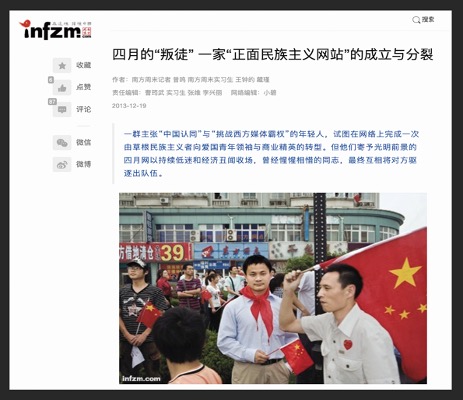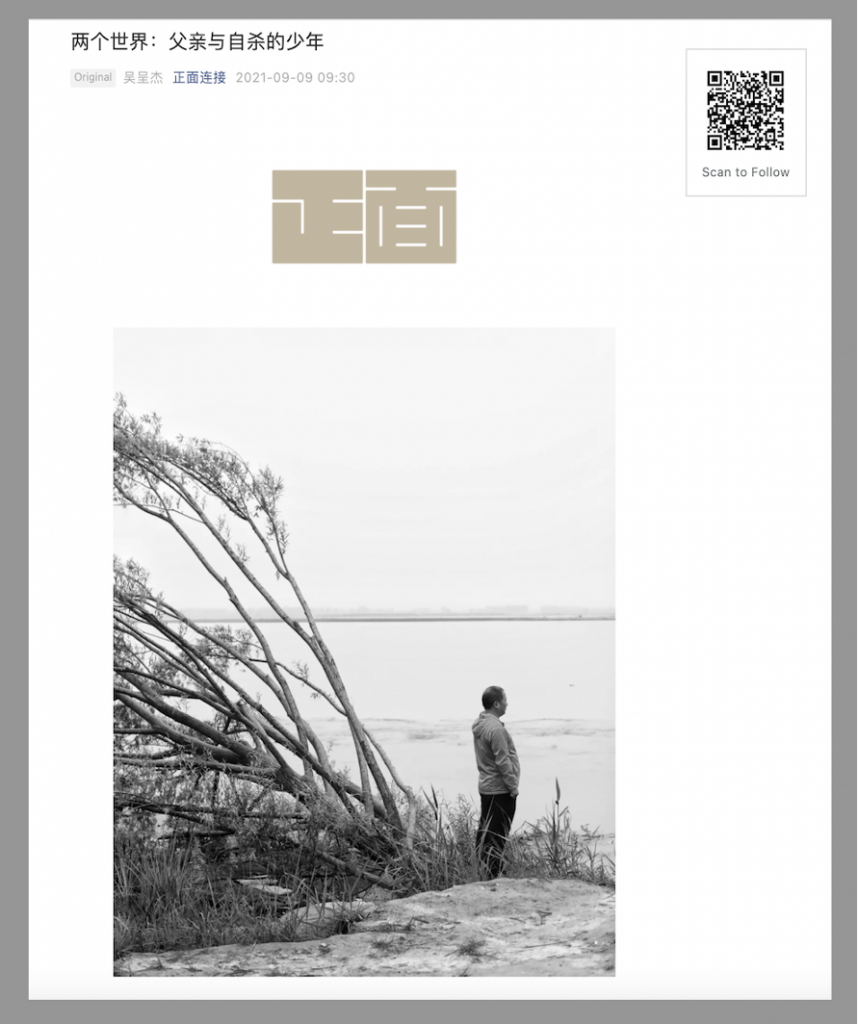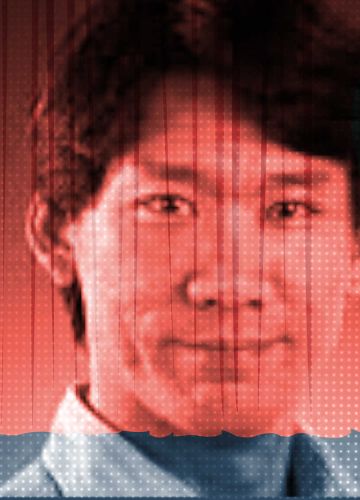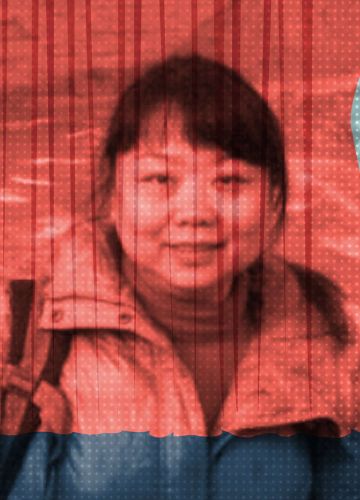Positive Connections: Confronting Complexity Through Nonfiction Writing

Fang Kecheng
In late September 2021, Fang Kecheng spoke with Zeng Ming (曾鸣), the founder of Positive Connections and a former journalist for Guangzhou’s Southern Weekly (南方周末), The Beijing News (新京报), and GQ China, about his professional experiences and his new venture.

Zeng Ming
Fang Kecheng: Hello, Zeng Ming. We’re old colleagues from Southern Weekly, and we both left around the same time. I was 2013 and you were 2014. I went to the U.S. for my Ph.D., taking the academic route, and you’ve stayed in journalism. Could you start by telling us why you left Southern Weekly and what you’ve been doing since you left?
Zeng Ming: After I left Southern Weekly in 2014, I worked at The Beijing News for four or five months, and then went to the Chinese edition of GQ in October 2014, and stayed there for six years. At first, I was a reporter. Actually, the title was “lead writer.” Then I started managing the whole reporting team. In 2018 I became editor-in-chief.
Fang Kecheng: What was your reason for leaving Southern Weekly? Were there some things you weren’t satisfied with at the time? If so, how did you fare at The Beijing News and GQ?
Zeng Ming: Some reasons for my departure at that time were coincidental. But there were also some very deep-seated reasons. I recall that the last piece I wrote for Southern Weekly was “April’s Traitors,” a piece about a nationalist website called “April Media.” I worked on the article for more than a month, and lots of colleagues were really surprised. Why did it take Zeng Ming such a long time to write an article? At that time, it was really rare to spend more than a month on a topic. But for me, I felt more and more that it really wasn’t enough to spend a week writing, or sometimes even less than a week .

Sometimes [as you’re working on an in-depth article] you don’t know the way forward. You probably know you need more time, more editorial support. You might need someone to provide a lot of emotional support and reassurance when you’re stuck in a bottleneck like that. But with Southern Weekly in a state of survival at that time, that kind of support was really hard to come by.
I thought about leaving and going to Beijing. But I had no idea where to go. One friend said to me, look, you’ll have to go to Beijing in the end anyway because Guangzhou won’t be a center for the media much longer. Since you’ll have to go to Beijing sooner or later, you might as well just go now. I thought this was good advice, so I moved on to The Beijing News.
One friend said to me, look, you’ll have to go to Beijing in the end anyway because Guangzhou won’t be a center for the media much longer.
About four or five months after that, I was on a business trip and chatting with a friend about the different story topics people were working on, and he mentioned another journalist, Lin Shanshan (林珊珊), who focused on feature articles. “Lin Shanshan has gone over to Esquire,” he said. Huh, I thought, why would she switch over to fashion and lifestyle? But he said it was because Esquire allowed a lot more time to work on stories, and my thought was, well, I need to find a place like that. It so happened that I was approached by the deputy editor of GQ at the time, and after talking with them I thought the arrangement was good, so I went. I never expected I would become editor-in-chief there.
The Decline of Market-Oriented Media in Guangzhou
Fang Kecheng: Listening to your story, it occurs to me that there are huge structural changes behind the scenes. One change, of course, is that Guangzhou is no longer the center of Chinese journalism. It had been the center of market-oriented journalism in China, probably since the late 1990s, with the Nanfang Media Group as the major anchor. But with the decline of market-oriented media [in China], and especially of the Nanfang Media Group – which has been under great political and economic pressure – Guangzhou has gradually faded as the center of Chinese media. It can’t compare with Beijing or even Shanghai.
Another structural change is the decline of market-oriented media. Doing in-depth reporting takes a lot of money and a huge investment of time. Who has resources like that anymore? In the golden age of market-oriented media, the Nanfang Media Group did have the resources. But resources diminished with time. And then it was lifestyle media, which had long been overlooked by the news industry, that offered opportunities.
Zeng Ming: You’re right. If you want to talk about structural factors, in the United States, GQ and Esquire have always been important places for New Journalism (新新闻主义) and non-fiction reporting. But even with so many editions of GQ around the world, it’s really only the U.S. and Chinese editions that go for nonfiction stories like this.
Fang Kecheng: Why is that?
Zeng Ming: Well, one reason is that China and the United States are rich in potential news stories. So many things are happening, things that are completely unprecedented. But another factor had to do with people. My last editor-in-chief, Wang Feng (王锋), who was actually from Lifeweek, was always really passionate about journalism and non-fiction writing. And then there was Li Haipeng (李海鹏), who worked as the head of feature topics at GQ. [NOTE: Li is one of the most recognized non-fiction journalists in China, and he helped to pioneer the unique style of feature writing at Southern Weekly.]
Fang Kecheng: The role individuals play within the media can definitely be important. So, for a fashion and lifestyle magazine, would you say your [feature story] content has a positive effect on advertising and sales?
Zeng Ming: Why can we say that Condé Nast is the most successful magazine group in the world? Because they produce premium brands. How do you achieve premium positioning? It depends on the overall quality of your magazine, on your degree of authority. You have to say that the content is good. But this is something that is difficult to quantify. There isn’t concrete data to tell us how much non-fiction stories add to the magazine. But there’s no question that it brings prestige. That’s a very important reason why a lot of people look at GQ differently.
The Cost of Getting It Right
Fang Kecheng: Why did you leave GQ?
Zeng Ming: During my six years at GQ, I was dissatisfied a lot of the time. At the start, I thought my job at GQ was really easy. A fashion magazine, it’s all just fanciful stuff, right? We come from the Southern Weekly background, so it’s got to be pretty easy to handle, right?
After I got there, I realized this wasn’t the case at all. I had the impression when I was at Southern Weekly that if I had to submit my article on Wednesday, I could pull an all-nighter on Tuesday and get it written. But at GQ it seemed like I was pulling all-weekers, and sometimes there were two-week stretches of constant work.
Fang Kecheng: Was it that hard?
Zeng Ming: Yes. The first piece I did for GQ was about Bitcoin. I was doing interviews for almost 2 months and writing for almost a month. I went to six different cities, including Hong Kong, Ordos in Inner Mongolia (which had the largest bitcoin mine in Asia at the time), Shanghai, Shenzhen, Changsha, and Beijing. I found all the important people you can name that were relevant to the development of bitcoin in China.

Fang Kecheng: Was this something demanded by your editor-in-chief at the time, or did you choose to do it yourself?
Zeng Ming: Actually, I didn’t communicate much with the editor at the time. That was mainly because, for the first time, I had time and space. You could go anywhere. You had the budget and there weren’t time pressures. After almost two full weeks of interviews, Wang Feng called me and asked me if the article was ready, and I said it would be difficult [to make the deadline], so he just said, Okay, next month then. I was like: Is this place really that relaxed? Just like that, you got an extra month. And of course, that’s a month you consider very valuable. I just kept thinking, where else could I go, where else should I go? And whenever I interviewed someone, they would introduce me to another source, and then another.
If you had asked me right after I left Southern Weekly, I would have said that two months was like infinity. So I wondered how far could I take the reporting, and how far I could take the writing? I found it was a totally different standard from that at Southern Weekly. I would say GQ was probably one or two levels higher. You have to write about all the important aspects, and you need to find connections between all the characters. And you have to write the article in a way that is as story-like as possible. It’s both an investigative piece and a feature piece. At Southern Weekly, and most other media outlets, investigative stories and feature stories are two separate things.
Fang Kecheng: I don’t know if it’s more about your character, or if it’s just like that when a journalist is given so much freedom in terms of time and space and layout.
Zeng Ming: I’m not sure. But I did find a lot of journalists later who were closer to my working style. If you give them three or four months, you can rest assured that they won’t be slacking off. They really will devote most of their time to interviewing and writing. Of course, it’s impossible to guarantee that they will be writing every day because they’ll hit an obstacle and need to depressurize.
After my last piece at GQ, “Li Xiaofeng, the Loser” (失败者李晓峰), I was left feeling really dissatisfied once it was finished. My deadline was January 1, 2016, and I sent it to Wang Feng at 11:59:57 p.m on December 31, 2015. Why did I take up all that time? Because sometimes you just can’t feel satisfied with it, and there isn’t enough time to finish it properly. You always feel that you can do a little better here and a little better there.
Fang Kecheng: You said a moment ago that after working for GQ for a few years, you were still unsatisfied. I thought you were going to say that you were dissatisfied with the magazine or the media environment. But it turns out that you were dissatisfied with your own work.
Zeng Ming: You could think of it this way . . . . Imagine you’re a person who loves learning. You need to at least graduate from high school, and if you can you want to finish college. But at GQ, we were maybe at the fourth-grade level. That’s definitely not good enough, right? We need to continue to work and improve ourselves. But the costs are greater and greater. When you set your sights that much higher, you need to invest more energy and resources.
This is a fundamental contradiction. To realize my ideas and plans, the hope is that at a certain point I can feel that the article sent out is something I don’t need to be ashamed about, but that makes me truly happy. That could take five years, or it might take 10 years, or even longer. Or it may take several groups of journalists who are capable writers, journalists who are promoted and become editors, who really improve at what they do – so that incoming writers get better support starting out, develop, become editors themselves, and so on and so forth. It might take several rounds of that to get to that level. But you would need to set very long-term goals, and your editorial culture and operational model would have to match it. But I can’t be too hard on an organization like GQ China with all these demands. It’s just too much. The pressure to control the production costs of GQ is very high.
To put it bluntly, it’s not a mission or goal of GQ [in China]. It’s probably is a mission of the American edition of GQ, which is to be the best magazine in America, to go for Pulitzer Prizes and National Magazine Awards. But frankly, in China, this is not what the magazine considers to be most important. So that’s why I say it’s a fundamental contradiction.
Just to give you a clear example, at Positive Connections the first two articles we published took nearly five months to complete. The total costs were nearly 200,000 yuan (31,000 US dollars) when you factor in salaries for reporters and editors, photography and travel. Frankly speaking, I don’t think even the American edition of GQ would provide that much financial support. I can’t reasonably expect that level of support from any media organizations in China.
The Attractions of the Subscription Model
Fang Kecheng: So, it sounds like you decided to form a team of your own to shoot for a higher standard.
Zeng Ming: In fact, I am not a very plan-oriented person. I just felt this was something I had to do, so I did it. As for what the costs would be, or where things would go, I didn’t really give it much thought. I knew on the other hand that GQ was a great platform, and I couldn’t imagine that kind of support somewhere else. So I had to go and do it myself.
So that’s when I started seeking investment. In fact, I haven’t been very diligent in seeking out investors. Maybe I talked to three or four people. But after you talk to three or four, you know talking with three or four hundred will be the same. First, they look at your business plan, your profitability, and so on. Some investors may want you to break even in the first two years and be profitable after that. But that’s something that’s almost impossible to guarantee. Interestingly, every [potential] investor I met with said they had great respect for GQ’s content, that they were loyal readers, that the articles are great. The message was, look, I’m very, very supportive, but I can’t invest. That wasn’t what they said directly, of course, but it’s essentially what they meant.
Finally, in October last year, with the connection provided by a former intern, we found an investment firm called Zhixin Capital. I briefly explained my whole plan to the founder, Li Shujun, over the phone. I sent him four or five manuscripts, each more than 10,000 characters in length. By the end of the night, he had read all of the drafts. After some back and forth, we started the process of working together. By February [2021], the first payment arrived. We started in March and prepared for about half a year. By the start of September we were online.
Fang Kecheng: It makes a lot of sense that the initial investment came from Zhixin Capital, because they’ve invested in a lot of so-called passion projects. They’re not so much in the pursuit of high returns, but care more about cultural value. Projects like “One Way Street Library” (单向街书店), [the social networking service] Douban (豆瓣), Goukr.com (果壳) [a web-based community for science and technology education], and Qyer.com (穷游网) [a website for travel enthusiasts].
Zeng Ming: When I talked to my friends, everyone said the company was a really responsible, professional, and meaningful organization. I felt that since all of my trusted friends said so, there was no need for me, with my limited financial know-how, to continue searching for investors.
Fang Ke Cheng: I’m curious, what kind of business plan did you give them? Your content is so cost-intensive, it seems really hard to make money.
Zeng Ming: In fact, I think it’s definitely workable. The model is subscription. I think subscription is the only attractive profit model in the new media era, and the only commercial model that can be a virtuous circle. The attractiveness comes in the fact that with subscription the costs are the same whether you sell to one person or to a thousand people.
I can explain how this positive cycle works. In the past, nearly all media outlets were dependent on distribution channels to survive. They sold content for free or close to free to readers, first building up influence and then going out and selling that influence to advertisers. Advertisers were the real bread and butter. A lot of media have been short-sighted [as a result of this model], resting on their laurels after they’ve developed their content to a certain level. Why? Because the most important thing is their distribution channel. There’s no incentive to improve the content. As Steve Jobs once said, if your sales department outgrows production, research and development and design, then your company is in real danger.
I think subscription is the only attractive profit model in the new media era, and the only commercial model that can be a virtuous circle.
In the media it’s [advertising] sales that brings in the money, and making content costs money. So if your articles are written to the 70-point level, that’s good enough. There’s no incentive to write to the 71-point level, much less to the 170-point level. For such [media], the respect of readers matters little if it doesn’t bring in more money. So it’s not the most important thing, nor is it something they’ll think about on a daily basis.
I remember my last year at GQ, I saw a corporate report showing that from 2019 to June 2020, The New Yorker had the fastest revenue growth because they had 2 million paying subscribers. Each person pays an average of about 50 dollars, which works out to around 100 million dollars [in revenue]. This is sustainable, and there’s a lot of room for growth. The better the magazine’s articles are written, the more people will subscribe – and as a result, more resources can be devoted to content. That’s a perfect, positive cycle.
Fang Kecheng: I understand. When you say paid model, I think it’s totally reliable. I’ve been doing a little subscription project myself for five years now – the subscription newsletter of News Lab (新闻实验室). It worked for my personally for this small project. And following new changes in the global media industry, one very clear signal in recent years is that the subscription model is a workable method for supporting the production of quality content.
So right now all of your articles are free. But later on, you will move to a subscription model. Is that right?
Zeng Ming: I think the process of moving from free to subscription is a long one, taking maybe five to eight years? Why? One of the primary issues, one we are powerless to really do anything about, is [technical] infrastructure [for accepting payments, etc.]. It requires really convenient platforms and software, and this is likely something that the big internet companies will need to provide.
Fang Kecheng: Yeah, there aren’t any decent platforms and tools yet. There’s the international company Stripe, but few Chinese people have credit cards, so this model can’t be applied directly. Credit cards can generate a very stable cash flow by enabling regular monthly payments.
Zeng Ming: Yes, I think it must be more user-friendly than what you’re talking about. But what exactly that way is, we may not know until it is built. For example, the payment amount could fluctuate, maybe having to do with how often you read content, or with your level of satisfaction, which would make it more in line with the positive correlation between content quality and payment. The whole set of payment systems, reading interfaces, copyright protection and so on are beyond our capacity. But you have to believe that this highway will be built to your doorstep one day.
The second issue is that everyone needs to be willing and in the habit of paying.
Fang Kecheng: Do you think we’re not there yet? A few days ago, for example, one of our former colleagues, Shou Ye (兽爷), wrote a paid article on his public WeChat account and made a lot of money.
Zeng Ming: If he makes a hundred million yuan, I’ll think that’s a lot of money. Or it needs to be a very dependable generation of income, not just the occasional [successful] story.
For us, in addition to the above two issues, there is the question of how often you update [with new content]. This is a very serious issue. We work on stories for around five months, and that means we can update our content on a weekly basis. To make daily updates, we would have to multiply the size of our staff by a factor of five. This is impossible because you can’t find enough people in China capable of writing this type of story – not to mention people capable of editing them, which is even rarer. This isn’t a problem that can be solved simply by having money. It requires training.
Of course, I’m confident that I’m gradually developing people. When I was at GQ, many of my writers hadn’t written features or non-fiction pieces before they started. There used to be this stereotype that GQ is the last stop for feature reporters, and I resented that, because there seemed something foolish about it – like you had to have it before you had it. It all seemed very rigid. Was it not possible to arrive as a fresh graduate?
I remember at that time, Yang Mei (杨眉) was the second writer I hired. She had just graduated, but before long I was assigning her the most difficult story topics. Everyone thought this wouldn’t work, and they urged me against it. But she wrote very well in the end. I think that with a good supportive environment, and with good editors, writers can develop very quickly. Of course, in the fastest cases, it may still take a year or two.
When you start out, your team is small and your capacity for training has limits, as each person’s time and energy is limited, but you still you have to work with them to rewrite the draft. You need to explain to them why this part is written this way, and not written that way. When they disagree, you have to listen to their viewpoint. After you publish it, you have to inspire in them the confidence to look at the longer-term possibilities for growth. So, I think it may take five to eight years before we have an editorial team of 50 to 70 people.
Fang Kecheng: So your investor is willing to give you that much time?
Zeng Ming: I may not have explained it to him with this level of detail.
Fang Kecheng: Oh my. We can’t let him overhear that!
Zeng Ming: It doesn’t matter if he hears. Of course, he understands that there isn’t magic in this world. Reading is easy, you either spend money or spend time. You spend money to make sure you’re reading quality content. Spending time you may read a hundred pieces of garbage before you stumble across something decent. With [building] a team it’s the same – you either spend money or time. It is useless to spend money if you don’t also spend the time, and this is the fastest way.
I’m sure a lot of companies are flush with cash, but even with the money they spend, I don’t believe they’ll be able to build strong editorial departments that are capable of producing very good content anytime soon. After we’ve been going for five to eight years, I think we’ll have more systematic standards, and that will be an important milestone for us.
Fang Kecheng: Meaning in the coming years, it will still be free, right?
Zeng Ming: Yeah. I think that’s the case unless you can deliver one or two very good pieces of content every day. Not that they would have to be very long, of course, but they would have to be very good. Right now we have 10 and 20,000-word stories that are doing well, but it’s still not enough.
For a good product, you need to have diverse content. For many readers, it’s enough to read a long piece once a month or once a week, as they can take a long time to finish. So, you need to have shorter pieces, short articles of three to five thousand words, special columns, and other new media offerings like short videos, podcasts, comics and so on. You have to use fresh language, and fresh forms of expression to share interesting content. Once you have full-fledged content to offer, then [your product is] worth paying for.
Fang Kecheng: So in the meantime, will you try other business models, such as selling rights?
Zeng Ming: Actually, we will. Two of our first three stories actually caught the attention of six or seven film and television companies. They talked about adaptations for film and TV. If that happens, great. If it doesn’t that’s fine too.
Once our operations stabilize a bit, we’ll also consider advertising. It’s still a relatively stable profit model. With advertising, you’ll be able to recruit more people and maintain a larger team. That will give your writers more time and space to work on more topics without distractions. Frankly speaking, the pressure on our editors is very high right now.
Fang Kecheng: It sounds pretty exciting. To use a word that is a little bit overused by many people nowadays, it’s long-termism (长期主义). I think this project of yours is very long-termist.
Zeng Ming: I remember one time talking with a group of people (I think we were still in school) and saying that we did these things not to change the world or to make something of ourselves, but because this is who we are. But once you start on your path, you start reflecting. You tell yourself one thing is vital and extremely important, and that’s responsibility. You need to be accountable to your partners and employees. You have a responsibility to your investors. And eventually you will have customers, and you’ll have to be responsible to them as well. Most importantly, you have a responsibility to your readers.
Pushing the Boundaries, Grappling With Complexity
Fang Kecheng: I understand. So let’s talk about the articles you’ve published. Among the first few articles, which one do you think is most representative? And why did you choose to publish the one about Hengshui Middle School first? What was your thinking there? [NOTE: The Hengshui Middle School article is a first-person reflection by the author on their time in high school at one of the country’s most competitive college prep institutions].
Zeng Ming: In fact, all three articles were completed around the same time. I thought they were all quite good, each having their own strengths. We considered all three for our launch. Why did we end up choosing the piece on Hengshui High School? That was on the advice of others. We actually spoke with people at [platforms like] Tencent (腾讯), Toutiao (今日头条) and others, and they all agreed that Hengshui High School was the best choice.
I’m very happy with the Hengshui piece myself. I’ve always emphasized the importance of exploring, breaking boundaries, and experimenting. To be honest, there aren’t many manuscripts out there like the Hengshui High School story. So this was pretty experimental.
Fang Kecheng: Is that because it uses the individual perspective of the journalist and a personal narrative style?
Zeng Ming: Well, that’s one of the reasons. It’s also important to note that a lot of people have written about Hengshui Middle School. But they’ve written about it as a public issue. About how teaching to the test is bad, that it dehumanizes students as if they are products on an assembly line. These voices existed before these pieces came out, and it’s a very clear and valid voice. If you echo such voices, you are just merging into a cacophony. That’s certainly a perfectly valid and responsible choice, but I don’t think it’s creative. I don’t think it’s something new.
But what is it actually like to attend school there? No one has talked about that. It just so happens one of our reporters, Du Meng (杜萌), graduated from Hengshui Middle School. So I talked to her about it and learned that she wrote her college graduation thesis about this.
The first time we chatted, we talked about a lot of things, such as the smell of Hengshui Middle School. She said they would often skip classes. But they didn’t go off to play – they went off to study. So why did they skip classes in the first place? It was because the classroom stank. As soon as I heard it, I thought: Yes, this is what I want, the feeling of really being inside.
This was nothing like the previous articles. She went on to talk about music. She used to listen to [Wang Feng’s] “Life in Full Bloom” (怒放的生命) after she woke [in the mornings], but she could never listen to the entire chorus through those years, because listening to all of it would have meant being late for school. I think these impressions are so real, so sincere, so accurate, and you have to be someone who lived it to be able to accurately describe such things.
People sometimes ask what criteria we have for our pieces, and often it’s just two things. The first is complexity. The second is accuracy. I think there are three dimensions to accuracy. There is factual accuracy. There is contextual accuracy. You can’t take things out of context, and you have to look at a person’s statements in their fullest context. And the most important thing, I think, is atmospheric accuracy, or the accuracy of the emotion.
This piece by Du Meng is the same. Having read so much, she would obviously understand that the educational system was wrong in its judgment of people and their worth. But she had lived there [at the school] for more than three years, and there was no way she could simply put her own life and the lives of her classmates on trial. She couldn’t do that. What she could do is very organically write about her memories. The emotion and the atmosphere of it all is what’s critical.
Because the topic had been covered sufficiently earlier, people were able to accept her very sharp and ruthless reflections on high school life. People could feel that she was not criticizing for the sake of criticism, not talking about the topic, not converging with a loud voice that already existed – but that she was expressing the voices of those who could not speak out. She was naming feelings and pains that had no name. This was something I looked forward to reading. I think cheap reflection is meaningless. If the reflection is not based on the person’s genuine emotion and thinking, then I think it is meaningless. It’s just air.
Fang Kecheng: What you’re saying here is very inspiring. As I was listening to you, I thought of the name of your publication, “Positive Connections.” Had it occurred to you that this name also conveys a sense of genuine connection, of confronting complexity?
Zeng Ming: In fact, our first thought was just to use the single word “Positive” as the name. But the WeChat public account for “positive” was registered. We contacted the person to buy it, because he had only posted three articles introducing himself, with only 20 people reading his posts. I asked him if he would sell it to us for 600 yuan? He jumped out with one million. Then I asked him, what about 1,000? No, one million, he said. We had no choice but to think of a new name.
The word “positive” is not a good word to be followed by anything. Calling it something like “Positive Story,” right? That’s so corny. Later, we thought about it and finally thought of the name “Connections.” Because society is so fragmented. We could act as a bridge, or like glue, enabling us to see one another, and to see more than just one side of things, so that we can connect. This is really what we’re about.
Fang Kecheng: I think “connection” is very good. Why did you choose the word “positive” in the first place?
Zeng Ming: Because we’ve been doing so-called “negative reporting” (负面报道). But I think the negative reports have a positive meaning, and so what we do are positive reports in that sense. I’ll show you the positive side.
Another meaning is that when we face things, we have to face them head-on, not in a roundabout way. It’s the most difficult thing, but I think it’s the most direct and most effective. We’re not going to do something just to consume and tug at your emotions – doing commentaries, rooting around in the baggage. When we do something, we are going to positively break through it, face it, and write it out.
The new media era has offered everyone all sorts of tools and possibilities. You now have 10 million ways to avoid things. You can do things more graciously, humorously, cost-effectively and profitably. But we hope to use this very basic way to speak positively about things. Of course, we don’t reject new ways of presenting things, but the core thing is to confront them head-on.
Kecheng Fang: If someone wants to join your team, to be trained by you and become a qualified team member, what sort of abilities do you want to see? What kind of people are the most capable in your eyes?
Zeng Ming: I think there are two things. One is curiosity. Does a person have a real, uncorrupted, instinctive curiosity? You can tell when you talk to them and read their words whether or not they have that kind of curiosity. The second is to be able to suffer. Many people will say that they can suffer, but many people misinterpret the true sense of suffering. Suffering is not about how many hours you can commit in a day.
Suffering is, first and foremost, is about accepting your shortcomings. You have to accept that you write badly, which is very painful, and you have to be able to change that. In other words, no matter what foundation you start with, you want to advance to the fifth and sixth grades instead of staying in the fourth grade forever. Mechanically spending a lot of effort, that’s not what you want.
Suffering is, first and foremost, is about accepting your shortcomings. You have to accept that you write badly, which is very painful, and you have to be able to change that.
Fang Kecheng: When you first described your experience at GQ, you said that people were always dissatisfied and there was a lot of criticism of each other’s articles. I wonder if this is also the case within your current team. Or to use your chosen keyword, “atmosphere,” what do you think the work atmosphere in your office is like?
Zeng Ming: We have a lot of young people, most of them post-90s, so it’s the usual post-90s atmosphere, which is very relaxed. But for the articles, the expectations are definitely a bit more rigorous. I have a friend who used to say that there are some jobs you can do sitting alone in a room, there are some jobs where you have to work shoulder to shoulder together, and then there are those jobs where you really need to work heart to heart together. In our work, we need to be connected heart to heart. We are like a big family.
Fang Kecheng: How many people do you have on your team?
Zeng Ming: There are about 10 people, and others are starting soon. One is on operations, and the others are all doing content.
Fang Kecheng: If your long-form articles take five months to produce, what exactly is the time and process in between like?
Zeng Ming: Each topic selection is different, but it starts, of course, with the pitching of ideas. When we started each person had to pitch at least three topics a week. But then we found it really difficult to find three workable topics, so not long ago we adjusted this to two. If you can find one that is workable, and you’ve contacted the relevant people before the [story] selection meeting, then you’ve done your homework and just one is enough.
Fang Kecheng: If a reporter is already working on a feature, do they still need to present a new topic each week?
Zeng Ming: It’s crucial. Because we feel you still need to maintain communication and connection with the world. You can’t be completely closed off.
Before interviews start, the editor and the writer discuss the topic and make anticipatory comments. While working on the piece, depending on the specific article, they may communicate daily. Every two or three days they’ll have at least one long phone conversation – anywhere from 40 minutes to two hours. I started this routine on my first day as an editor at GQ. We would talk on the phone. What did you get today? What did you see? What did you hear? How have you revised our previous expectations and themes? What are the breakthroughs we need next? What are some of the difficulties, and how should we overcome them?
Unexpected situations always come up in the draft process. For some interviews, you have to go back a second time. For example, in our second piece, about a father and his teenage son who committed suicide (两个世界:父亲与自杀的少年), we believed most of what the father told us when we made our first trip to Zhengzhou. But then we kept feeling the more we thought about it that something wasn’t right.
We eventually went back because we wanted to film, and we did more extensive interviews. We made it a point to track down the son’s class teacher. Why hadn’t we spoken with the teacher the first time round? Because the father hadn’t yet publicized his son’s suicide. If we did make contact with the teacher, we had to make sure we were respectful of all people concerned.
It was during the second interview that all sorts of issue came up, which meant many important aspects of the son’s life had to be taken into account. At that point a lot of good friends of mine, including some very experienced non-fiction writers, said we should stop. Just think, they said, this father has just lost his child and you’re going to accuse him of lying. What would people on the internet think of that? The internet can eat you up. But since I hadn’t actively used Weibo for about five years I wasn’t so in touch with the environment. “Would it be that serious?” I asked. He gave me a few examples of just how serious it would be.
But I’m always of a mind that things can be solved. When we were in post-production, another editor made an important comment, saying that the version we had at the time felt like we were challenging the father. It wasn’t wrong to challenge him, but we had to consider first that this was a father who had lost his child. Then I got this editor more involved in the editing process.
We spent a lot of time going through previous drafts, and we went to great lengths to ask the author what the father was like when he said this, or where he said it. Did he cry? How did he cry? These seemed like tiny, insignificant details, and he didn’t necessarily add them all. But he kept on making adjustments. The first was to present the story from the father’s point of view.

Another structural adjustment was to end the article with a section where we dealt with the image of the father, talking about what he said that was wrong and untrue. We also related some of his previous experiences and his emotions about his son.
Just think, they said, this father has just lost his child and you’re going to accuse him of lying. What would people on the internet think of that? The internet can eat you up.
Finally, we asked a lot of people before we published it whether they felt we were offending the father in any way. We wanted to make sure we weren’t scandalizing or attacking him. Almost everyone said no, and I was relieved. In fact, the whole article hadn’t been changed significantly, it was just that there had been some changes to the mood and atmosphere, and some re-balancing. But this probably took us a month or two.
Fang Kecheng: I also felt that the overall feeling was compassion when I read it. So I don’t think it triggered online violence afterward, right?
Zeng Ming: None. Later, after the father read the article, he said the writer was a welcome guest in their home anytime.
Fang Kecheng: I think every one of your articles is wonderful. There are a lot of interesting things behind each one to talk about, I think we could do a podcast about these behind-the-scenes stories.
Zeng Ming: We’re also considering having videos. Recently we started looking for professional people to see if it’s possible.
Translation and editing by Sara M. Yurich.
The Chinese podcast of Fang Kecheng’s interview can be found here

Fang Kecheng








